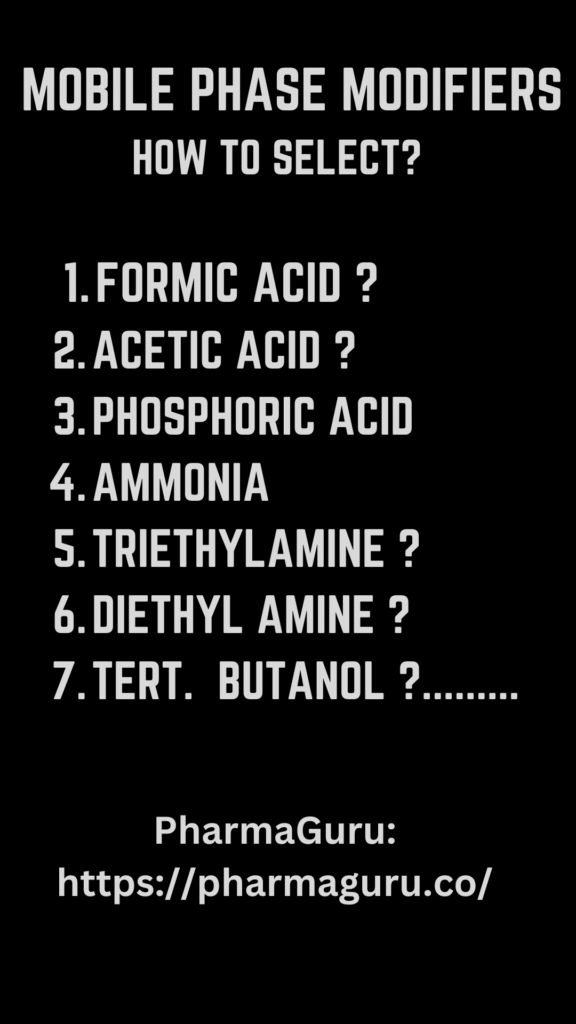HPLC Mobile phase modifiers—such as trifluoroacetic acid and triethylamine—are chemical additives incorporated into the mobile phase to enhance peak efficiency, resolution, elution profiles, and selectivity in HPLC separations High-Performance Liquid Chromatography (HPLC) is a cornerstone technique in analytical chemistry for separating, identifying, and quantifying compounds in a mixture. One of the most critical aspects of […]
HPLC Mobile phase modifiers—such as trifluoroacetic acid and triethylamine—are chemical additives incorporated into the mobile phase to enhance peak efficiency, resolution, elution profiles, and selectivity in HPLC separations
High-Performance Liquid Chromatography (HPLC) is a cornerstone technique in analytical chemistry for separating, identifying, and quantifying compounds in a mixture. One of the most critical aspects of achieving optimal separation in HPLC is the mobile phase, particularly the use of mobile phase modifiers.
This blog explores what mobile phase modifiers are, their types, how to select them, their concentration, their effects on separation, and real-world case studies that illustrate their importance.

Mobile phase modifiers are chemical additives introduced into the mobile phase to improve the efficiency, resolution, and selectivity of chromatographic separations. They interact with the analytes and/or the stationary phase to modify retention times, peak shapes, and overall chromatographic performance.
You may like: Relative Response Factor (RRF) in Pharmaceutical Analysis
The following types of HPLC modifiers are widely used :
Used primarily in reverse-phase HPLC (RP-HPLC), pH modifiers control the ionization state of analytes, thereby affecting their retention and selectivity.
Used in ion-pair chromatography, these reagents form neutral or charged complexes with ionic analytes to increase retention.
These alter the polarity of the mobile phase and are critical in changing elution strength.
Used to reduce peak tailing and improve reproducibility by masking residual silanol groups on silica columns.
The following 5 key factors are considered while selecting the modifier:
Modifier concentration has a direct impact on retention, resolution and elution profile:
General Guidelines:
Too little modifier can lead to poor peak shape or inadequate buffering. Too much can damage detectors (e.g., MS) or alter retention unpredictably.
| Modifier Type | Effect on Chromatography |
|---|---|
| pH Modifier | Increases the retention of ionic compounds |
| Buffer | Improves reproducibility and peak symmetry |
| Ion-pairing Reagent | Reduces the tailing of basic compounds |
| Organic Solvent | Controls elution strength and resolution |
| Silanol Blockers | Reduces tailing of basic compounds |
Case Study 1: Using Formic Acid in LC-MS
A pharmaceutical lab was unable to detect a basic compound using standard phosphate buffer (non-volatile). Switching to 0.03% formic acid improved peak shape and made the method compatible with LC-MS.
Case Study 2: Ion-Pairing for Sulfonate Compounds
A sulfonate drug showed poor retention in RP-HPLC. The addition of 5 mM tetrabutylammonium hydrogen sulfate allowed better retention and resolution, enabling robust quantitation.
Case Study 3: TEA as a Silanol Blocker
Analysis of a basic alkaloid led to significant tailing. Inclusion of 0.1% triethylamine (TEA) in the mobile phase suppressed silanol interaction, producing sharp, symmetric peaks.
| Feature | Impact |
|---|---|
| Definition | Additives in mobile phase to enhance separation |
| Types | Buffers, pH modifiers, ion-pairing reagents, organic solvents |
| Selection Criteria | Analyte nature, detection method, volatility |
| Concentration | Depends on purpose; buffer ~5–50 mM, acid/base ~0.1% |
| Effect | Influences retention, resolution, peak shape, selectivity |
HPLC modifies:
Related:
Choosing the right mobile phase modifier is often the key to unlocking optimal separation in HPLC. It requires a solid understanding of analyte chemistry, method requirements, and compatibility with detection systems. Always start with small-scale trials, and consider both short-term efficiency and long-term robustness of your method.
If you’re developing a method or troubleshooting a stubborn peak, feel free to share your problem—I can help recommend suitable modifiers or strategies based on your compound and instrumentation.
Mobile phase modifiers improve the chromatographic performance by adjusting the mobile phase’s pH, polarity, or ionic strength. This affects analyte retention, selectivity, peak shape, and resolution. Modifiers are especially critical when analyzing ionizable or strongly retained compounds.
Formic acid: Volatile and MS-compatible; good for LC-MS applications.
TFA: Stronger acid, excellent peak shape; but may suppress ionization in MS.
Phosphoric acid: Non-volatile, strong buffering capacity; ideal for UV detection but not MS-friendly.
No, non-volatile modifiers like phosphate or sulfate buffers are not suitable for LC-MS. They can cause ion suppression, signal interference, and damage to the ion source. Use volatile modifiers such as ammonium formate or formic acid for MS applications.
Modifier concentration affects:
Retention time: Higher concentrations can increase or decrease retention depending on the analyte.
Peak shape: Adequate concentrations improve peak symmetry.
Buffering: Too little modifier results in poor control of pH; too much can harm detectors or cause precipitation.
Always optimise the concentration during method development.
Quick Links